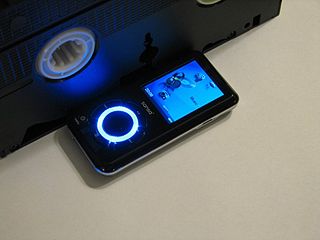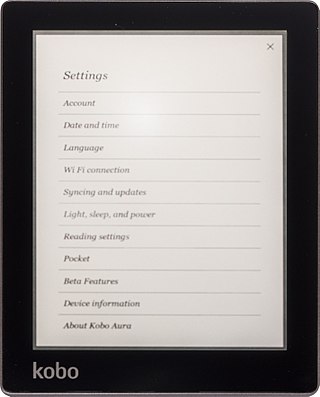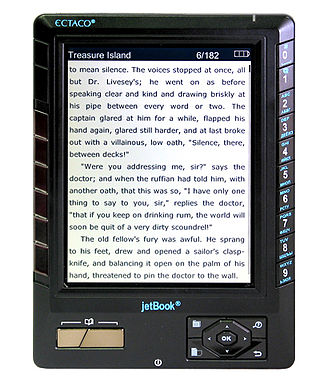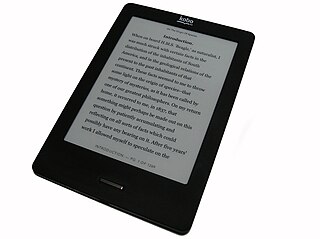
The Sony Reader (ソニー・リーダー) was a line of e-book readers manufactured by Sony. The first model was the PRS-500 released in September 2006 and was related to the earlier Sony Librie, the first commercial E Ink e-reader in 2004 using an electronic paper display developed by E Ink Corporation. The last model was the PRS-T3, after which Sony announced it would no longer release a new consumer e-reader.

The Sansa e200 series is a portable media player developed by SanDisk and released on January 5, 2006. The device is available in four capacities of Flash memory: 2 GB (e250), 4 GB (e260), 6 GB (e270), and 8 GB (e280). All players have a 1.8-inch, TFT LCD display with a resolution of 176 by 220 pixels. Certain files, if not in a format accepted by the player's original firmware, must first be converted with the Sansa Media Converter Windows software. This will convert images to bitmap format (.bmp) and videos to MJPEG, for v1 models. On v2 players it will convert videos to DivX and simply resize images. It is not possible to simply copy videos to the device, even if they seem to be in the correct format; trying to access them displays an error message.

An e-reader, also called an e-book reader or e-book device, is a mobile electronic device that is designed primarily for the purpose of reading digital e-books and periodicals.
Cybook Gen3 is a 6-inch (15.2 cm) e-reader for reading e-books and periodicals, and it can be used to listen to MP3 and audiobook files. It was produced by the French company Bookeen.
Amazon Kindle is a series of e-readers designed and marketed by Amazon. Amazon Kindle devices enable users to browse, buy, download, and read e-books, newspapers, magazines and other digital media via wireless networking to the Kindle Store. The hardware platform, which Amazon subsidiary Lab126 developed, began as a single device in 2007. Currently, it comprises a range of devices, including e-readers with E Ink electronic paper displays and Kindle applications on all major computing platforms. All Kindle devices integrate with Windows and macOS file systems and Kindle Store content and, as of March 2018, the store had over six million e-books available in the United States.

The Hanlin is an e-Reader, an electronic book (e-book) reading device. The Hanlin v3 features a 6" (15 cm), 4-level grayscale electrophoretic display with a resolution of 600×800 pixels, while the v3+ features a 16-level grayscale display. The Hanlin v5 Mini, features a 5" (15 cm), 8-level grayscale electrophoretic display with a resolution of 600×800 pixels. The device runs a Linux-based OS.

Bookeen is a French company dealing with e-books and consumer electronics.
Digital newspaper technology is the technology used to create or distribute a digital newspaper.
The eSlick is a discontinued e-book reader, an electronic book (e-book) reading device developed by Foxit Software. It has a 6-inch E Ink screen, 600x800 pixel resolution with 4-level gray scale and a mass of 180 g. The device supports text and PDF format for reading and includes Foxit's PDF Creator and Reader Pro Pack software. In August 2010, Foxit announced that it would stop further development of the eSlick and focus on licensing PDF software to the makers of other e-book hardware. Wired attributed the move to a price war between Amazon.com's Kindle and Barnes & Noble's Nook which undermined Foxit's claim to offer the cheapest e-book reader on the market. Foxit dropped its support completely and abruptly in 2010, completely deleting all references to the eSlick from its site, including numerous forum threads and all firmware updates. This action has alienated and angered many users, as the solutions to many problems were readily available in these threads.

The Kobo eReader is an e-reader produced by Toronto-based Kobo Inc. The company's name is an anagram of "book". The original version was released in May 2010 and was marketed as a minimalist alternative to the more expensive e-book readers available at the time. Like most e-readers, the Kobo uses an electronic ink screen. The Arc tablet series, released between 2011 and 2013, was based on LCD technology instead.

ECTACO jetBook is a series of electronic-book reader devices developed by Ectaco. The original device was announced in the United States in October 2008.

4FFF N618 is a discontinued electronic-book reader developed by an Indian Company, Condor Technology Associates, and based on a Linux platform. The device is sold under various brand names worldwide.

The Nook Color is a tablet computer/e-reader that was marketed by Barnes & Noble. A 7-inch (18 cm) tablet with multitouch touchscreen input, it is the first device in the Nook line to feature a full-color screen. The device is designed for viewing of books, newspapers, magazines, and children's picture books. A limited number of the children's books available for the Nook Color include interactive animations and the option to have a professional voice actor read the story. It was announced on 26 October 2010 and shipped on 16 November 2010. Nook Color became available at the introductory price of US$249. In December 2011, with the release of the Nook Tablet, it lowered to US$169. On 12 August 2012, the price lowered to US$149. On 4 November 2012, the price was further lowered to US$139. The tablet ran on Android.
Qisda ES900 is a discontinued electronic-book reader developed by Qisda Corporation and based on a Linux platform. The device is sold under various brand names worldwide.

The Kobo Touch is the third generation of the Kobo e-reader device designed by Kobo Inc. It was revealed on 23 May 2011 and was released in the U.S. on 10 June 2011 at a price of $129.99.

The Kobo Glo is the fourth generation of Kobo eReader devices designed and marketed by Kobo Inc. It was revealed on 6 September 2012 and arrived at retail 14 October 2012 with a price of $129.99 USD/CAD. It is the successor to the popular Kobo Touch was introduced alongside the Kobo Mini and Kobo Arc. The Glo was succeeded in 2015 by the higher-resolution Glo HD, with 4GB built-in storage but no microSD removable storage.
The Kobo Mini is a miniature, touch-based e-book reader produced by Kobo Inc.
The Kobo Aura HD is a limited-edition Kobo eReader device designed and marketed by Kobo Inc. It was revealed 15 April 2013 and allowed for preorders the next day at a price of 169.99 USD/CAD. It arrived in stores in Canada and the United Kingdom on 25 April 2013. The marketing slogan of the Kobo Aura HD was "The eReader, reimagined." In October 2014 the Kobo Aura H2O was launched, it has a similar screen resolution to the Kobo Aura HD but has a waterproof coating. Kobo's CEO announced in March 2015 that the Kobo Aura HD was officially discontinued.

The Kobo Aura is the fifth generation of E-book readers designed and marketed by Kobo Inc. It was revealed 27 August 2013 at Kobo's Beyond the Book Event in New York City, along with three new Kobo Arc devices. Available for pre-order the same day, it cost $149.99 USD/CAD.

The Samsung YP-R0 is a portable media player made by Samsung, leaked on August 10, 2009 and first released end of October 2009 in Russia. It was developed along with the YP-R1 with which it shares several specifications . The R0 is available in three different Flash memory capacities: 4 GB, 8 GB, and 16 GB. It comes in three different colors: black, silver and pink. Storage is expandable via a microSDHC slot with capacity up to 32 GB, and unofficially to 64GB or more via FAT32 formatted SDXC cards. It features an aluminum case, a 2.6 inch TFT LCD display with a resolution of 240 by 320 pixels, RDS FM tuner, tactile buttons and microUSB connector. Several EQ and sound effects are available through Samsung's DNSe 3.0 sound engine.











